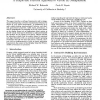Free Online Productivity Tools
i2Speak
i2Symbol
i2OCR
iTex2Img
iWeb2Print
iWeb2Shot
i2Type
iPdf2Split
iPdf2Merge
i2Bopomofo
i2Arabic
i2Style
i2Image
i2PDF
iLatex2Rtf
Sci2ools
107
Voted
SI3D
1995
ACM
1995
ACM
Object Associations: A Simple and Practical Approach to Virtual 3D Manipulation
This paper describes a software framework to aid in designing and implementing convenient manipulation behaviors for objects in a 3D virtual environment. A combination of almost realistic-looking pseudo-physical behavior and idealized goal-oriented properties, called object associations, is used to disambiguate the mapping of the 2D cursor motion on the display screen into an appropriate object motion in the 3D virtual world and to determine a valid and desirable final location for the objects to be placed. Objects selected for relocation actively look for nearby objects to associate and align themselves with; an automated implicit grouping mechanism also falls out from this process. Concept, structure, and our implementation of such an object association framework in the context of the Berkeley Soda Hall WALKTHRU environment are presented.
Appropriate Object Motion | Computer Graphics | Convenient Manipulation Behaviors | Object Association | SI3D 1995 |
Related Content
| Added | 26 Aug 2010 |
| Updated | 26 Aug 2010 |
| Type | Conference |
| Year | 1995 |
| Where | SI3D |
| Authors | Richard W. Bukowski, Carlo H. Séquin |
Comments (0)

